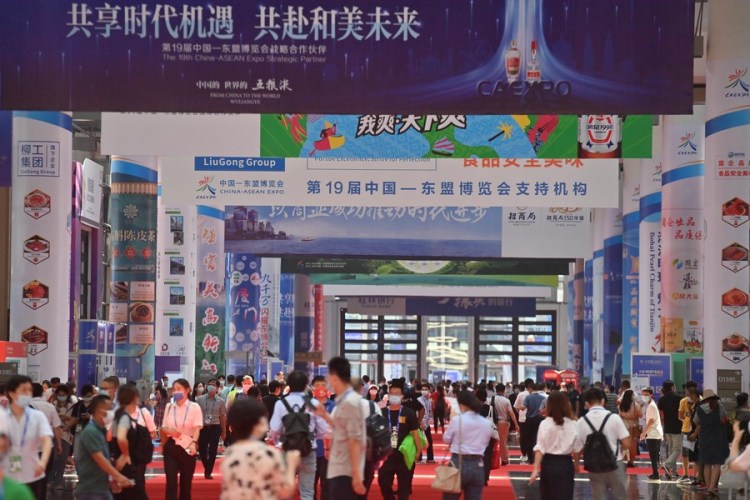As a new effort to strengthen bilateral relationship and cooperation, China and ASEAN countries agreed at the 25th China-ASEAN Summit earlier this month to continue to promote regional economic integration, and jointly announced the official launch of negotiations on a new round of upgrade of their free trade area.

by Xinhua writer Wu Liming
BEIJING, Nov. 25 (Xinhua) -- Earlier this month, China and members of the Association of Southeast Asian Nations (ASEAN) issued a joint statement on the South China Sea at the 25th China-ASEAN Summit held in Phnom Penh of Cambodia.
In keeping with the spirit of the Declaration on the Conduct of Parties in the South China Sea (DOC) that has been in place for 20 years, the joint statement has shown the world not only the common will and determination of China and ASEAN members to make the South China Sea a sea of peace, friendship and cooperation, but also their readiness to advance consultations on the Code of Conduct (COC) in the sea and confidence in reaching consensus on the COC at an early date.
For a long time, a few countries outside the region have deliberately distorted facts, stirred up tensions and incited confrontation in the region. Washington, in particular, has exerted itself to hype up a so-called threat to the "freedom of navigation" in the South China Sea, a claim purely fabricated.
The fact is while some 100,000 merchant vessels now travel in this busy shipping route annually, not a single ship has ever reported its safety threatened in the South China Sea.
In fact, Washington's claimed threat to the "freedom of navigation" is more accurate when used to describe its own increasing military presence in the region. Under the pretext of navigation freedom, the United States frequently sends its warships and aircraft carriers to the regional waters, and has conducted a multitude of war games. Such a naked show of force is practically heightening tensions in the Asia-Pacific, and undermining peace and stability there.
As clear as it can be, China's sovereignty, rights and interests in the South China Sea have been formed in the course of a long history, and have abundant historical and legal basis. It is also patent and above-board that China advocates maintaining peace, stability and unimpeded shipping lanes in the South China Sea, since the "freedom of navigation" in the sea serves the interests of all parties, including those of China.
Being the world's biggest trader of goods, China has 60 percent of its cargoes shipped through the South China Sea. Seven out of the 10 biggest ports by cargo volume in the world are located in China, from which large amounts of goods are shipped by foreign navigation firms to other parts of the world through the South China Sea. If the "freedom of navigation" was jeopardized, China would be the top victim.
For the United States and other countries outside the region, which have been muddying the waters in the South China Sea in an attempt to sow discord between China and regional countries, they probably have felt a let-down with the release of the joint statement in Phnom Penh, as it would be more difficult for them to sow new discord between China and ASEAN countries.
In fact, the relationship between China and ASEAN has been, and continues to be sound, healthy and robust. ASEAN countries have long been China's close neighbors across the sea, trustworthy friends and partners of common development, and China has vowed to unswervingly treat ASEAN as a high priority in its neighborhood diplomacy.

As the first to forge a strategic partnership with ASEAN, China is also the first to join the Treaty of Amity and Cooperation in Southeast Asia, and the first to start negotiations on a free trade area with the regional bloc.
China and ASEAN became each other's largest trading partner in 2020. In the first 10 months of 2022, ASEAN continued to be China's largest trading partner, whose trade volume with China accounted for 15.2 percent of the country's total foreign trade.
In a push for common development, China and ASEAN have signed and implemented the Regional Comprehensive Economic Partnership (RCEP) and jointly built the world's largest free trade area, upgrading their development to a new level.
As a new effort to strengthen bilateral relationship and cooperation, China and ASEAN countries agreed at the 25th China-ASEAN Summit earlier this month to continue to promote regional economic integration, and jointly announced the official launch of negotiations on a new round of upgrade of their free trade area.

A failed meddling of U.S. Vice President Kamala Harris has proven again the stability of the China-ASEAN relations.
During her recent trip to the Philippines, Harris brought up "the freedom of navigation" cliche again to drive new wedges into the region. However, with hollow pledges like "the United States stands with the Philippines" and the mentality of zero-sum game and bloc politics, she found herself out of accord with the rhythm and harmony of the region.
All in all, China and ASEAN countries have wisdom and capacity to resolve differences and keep the key in their own hands to handling issues related to the South China Sea. Building the South China Sea into a sea of peace, friendship and cooperation is their common goal and determination. It is wise for countries outside the region to stop meddling in the South China Sea.





